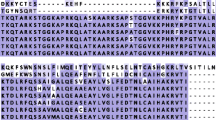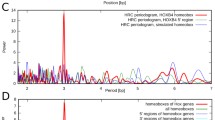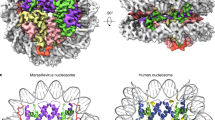Summary
The organization of histone gene clusters of the duckCairina moschata was studied in the DNA inserts of two recombinant phage that overlap and feature identical histone gene arrangements but differ in sequence details and in the extent of repetition of an AT-rich motif in one of the nontranscribed spacer regions. These few but substantial differences between otherwise nearly identical histone gene groups suggest that we have independently isolated alleles of the same site of the duck genome or that this gene arrangement occurs (with slight variations) more than once per haploid genome. Within the histone gene cluster described, H3 and H4 genes are duplicated (with inverted orientation), whereas one H1 gene is flanked by single H2A and H2B genes. The arrangement of duck histone genes described here is identical to a subsection of the chicken genome but differs from any other published histone gene cluster.
Similar content being viewed by others
References
Benton D, Davis RW (1977) Screening λgt recombinant clones by hybridization to single plaques in situ. Science 196:180–182
Birnstiel ML, Busslinger M, Strub K (1985) Transcription termination and 3′ processing: the end is in site! Cell 41:349–359
Breathnach R, Chambon P (1981) Organization and expression of eucaryotic split genes coding for proteins. Annu Rev Biochem 50:349–383
Cohn RH, Kedes LH (1979) Nonallelic histone gene clusters of individual sea urchins (Lytechinus pictus): mapping of homologies in coding and spacer DNA. Cell 18:855–864
Coles LS, Wells JRE (1985) An H1 histone gene-specific 5′ element and evolution of H1 and H5 genes. Nucleic Acids Res 13:585–594
Currier TC, Nester EW (1976) Isolation of covalently closed circular DNA of high molecular weight from bacteria. Anal Biochem 76:431–441
Czelusniak J, Goodman M, Hewett-Emmett D, Weiss ML, Venta PJ, Tashian RE (1982) Phylogenetic origins and adaptive evolution of avian and mammalian haemoglobin genes. Nature 298:297–300
D'Andrea RJ, Coles LS, Lesnikowski C, Tabe L, Wells JRE (1985) Chromosomal organization of chicken histone genes: preferred associations and inverted duplications. Mol Cell Biol 5:3108–3115
Dodgson JB, Engel JD (1983) The nucleotide sequence of the adult chicken α-globin genes. J Biol Chem 258:4623–4629
Doenecke D, Tönjes R (1984) Conserved dyad symmetry structures at the 3′ end of H5 histone genes Analysis of the duck H5 gene. J Mol Biol 178:121–135
Doenecke D, Tönjes R (1986) Differential distribution of lysine and arginine residues in the closely related histones H10 and H5. Analysis of a human H10 gene. J Mol Biol 187:461–464
Engel JD, Rusling DJ, McCune KC, Dodgson JB (1983) Unusual structure of the chicken embryonic α-globin gene, π′. Proc Natl Acad Sci USA 80:1392–1396
Erbil C, Niessing J (1983) The primary structure of the duck αD-globin gene: an unusual 5′ splice junsction sequence. EMBO J 2:1339–1343
Georgiev O, Birnstiel ML (1985) The conserved CAAGAAAGA spacer sequence is an essential element for the formation of 3′ termini of the sea urchin H3 histone mRNA by RNA processing. EMBO J 4:481–489
Goldberg ML (1979) Sequence analysis ofDrosophila histone genes. PhD thesis, Stanford University, Stanford CA
Grandy DK, Engel JD, Dodgson JB (1982) Complete nucleotide sequence of a chicken H2B histone gene. J Biol Chem 257: 8577–8580
Heintz N, Zernik M, Roeder RG (1981) The structure of the human histone genes: clustered but not tandemly repeated. Cell 24:661–668
Hentschel CC, Birnstiel ML (1981) The organization and expression of histone gene families. Cell 25:301–313
Krieg PA, Robins AJ, D'Andrea RJ, Wells JRE (1983) The chicken H5 gene is unlinked to core and H1 histone genes. Nucleic Acids Res 11:619–627
Lomedico P, Rosenthal N, Efstratiadis A, Gilbert W, Kolodner R, Tizard R (1979) The structure and evolution of the two nonallelic rat preproinsulin genes. Cell 18:545–558
Maniatis T, Fritsch EF, Sambrook J (1982) Molecular cloning. A laboratory manual. Cold Spring Harbor Press, Cold Spring Harbor NY
Maxam AM, Gilbert W (1977) A new method for sequencing DNA. Proc Natl Acad Sci USA 74:560–564
Maxson R, Cohn R, Kedes L, Mohun T (1983) Expression and organization of histone genes. Annu Rev Genetics 17:239–277
Niessing J, Erbil C (1983) Chromosomal arrangement and the complete nucleotide sequence of the duck α-like globin genes αA, αD and π. In: Schnek G, Paul C (eds) Brussels hemoglobin symposium 1983. Editions de l'Université de Bruxelles. Brussels, pp 421–432
Niessing J, Erbil C, Neubauer V (1982) The isolation and partial characterization of linked αA- and αD-globin genes from a duck DNA recombinant library. Gene 18:187–191
Old RW, Woodland HR, Ballantine JEM, Aldridge TC, Newton CA, Bains WA, Turner PC (1982) Organization and expression of cloned histone gene clusters fromXenopus laevis andX. borealis. Nucleic Acids Res 10:7561–7580
Overton GC, Weinberg ES (1978) Length and sequence heterogeneity of the histone gene repeat unit of the sea urchin,S. purpuratus. Cell 14:247–257
Perler F, Efstratiadis A, Lomedico P, Gilbert W, Kolodner R, Dodgson J (1980) The evolution of genes: the chicken preproinsulin gene. Cell 20:555–566
Rigby PWJ, Dieckmann M, Rhodes C, Berg P (1977) Labeling deoxyribonucleic acid to high specific activity in vitro by nick translation with DNA polymerase I. J Mol Biol 113:237–251
Ruiz-Carrillo A, Affolter M, Renaud J (1983) Genomic organization of the genes coding for the main six histones of the chicken: complete sequence of the H5 gene. J Mol Biol 170: 843–859
Schaffner W, Gross K, Telford J, Birnstiel M (1976) Molecular analysis of the histone gene cluster ofPsammechinus miliaris: II The arrangement of the five histone-coding and spacer sequences. Cell 8:471–478
Sierra F, Lichtler A, Marashi F, Rickles R, van Dyke T, Clark S, Wells J, Stein GS, Stein J (1982) Organization of human histone genes. Proc Natl Acad Sci USA 79:1795–1799
Sittman DB, Chiu IM, Pan CJ, Cohn RH, Kedes LH, Marzluff WF (1981) Isolation of two clusters of mouse histone genes. Proc Natl Acad Sci USA 78:4078–4082
Southern EM (1975) Detection of specific sequences among DNA fragments separated by gel electrophoresis. J Mol Biol 98:503–517
Sugarman BJ, Dodgson JB, Engel JD (1983) Genomic organization, DNA sequence, and expression of chicken embryonic histone genes. J Biol Chem 258:9005–9016
Tönjes R, Doenecke D (1985) Structure of a duck H3 variant histone gene: a H3 subtype with four cysteine residues. Gene 39:275–279
Tönjes R, Doenecke D (1987) A highly conserved sequence in H1 histone genes as oligonucleotide hybridization probe: isolation and sequence of a duck H1 gene. J Mol Evol 25:361–370
Turner PC, Aldridge TC, Woodland HR, Old RW (1983) Nucleotide sequences of H1 histone genes fromXenopus laevis. A recently diverged pair of H1 genes and an unusual H1 pseudogene. Nucleic Acids Res 11:4093–4107
Vitelli L, Weinberg ES (1983) An inverted sea urchin histone gene sequence with breakpoints between TATA boxes and mRNA cap sites. Nucleic Acids Res 11:2135–2153
Wang SW, Robins AJ, D'Andrea R, Wells JRE (1985) Inverted duplication of histone genes and disposition of regulatory sequences. Nucleic Acids Res 13:1369–1387
Wells D, Bains W, Kedes L (1986) Codon usage in histone gene families of higher eukaryotes reflects functional rather than phylogenetic relationships. J Mol Evol 23:224–241
Winkfein RJ, Connor W, Mezquita J, Dixon GH (1985) Histone H4 and H2B genes in rainbow trout (Salmo gairdnerii). J Mol Evol 22:1–19
Zwollo P, Stein GS, Stein JL (1984) Variations in the organization of human genomic DNA segments containing H1 histone genes. Biochem Biophys Res Commun 124:988–993
Author information
Authors and Affiliations
Rights and permissions
About this article
Cite this article
Tönjes, R., Munk, K. & Doenecke, D. Conserved organization of an avian histone gene cluster with inverted duplications of H3 and H4 genes. J Mol Evol 28, 200–211 (1989). https://doi.org/10.1007/BF02102477
Received:
Revised:
Accepted:
Issue Date:
DOI: https://doi.org/10.1007/BF02102477




